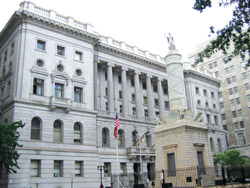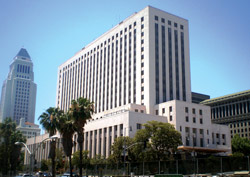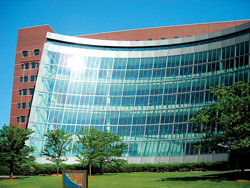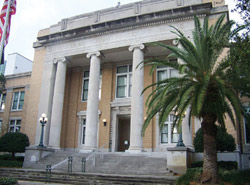Sustaining Justice: 10 Experts Tell How Courts Can Do More with Less

Illustration by Randy Lyhus
American courts are facing perhaps their worst crisis in decades. When the recession kicked into high gear, courts already besieged with heavy dockets found themselves taking on even more cases as growing numbers of individuals and families faced foreclosures, bankruptcies, collections, employment disputes and domestic relations matters. Many of those people opted for self-representation, a choice that puts even more pressure on judges and court personnel.
But now the other shoe has dropped, as state legislators desperate to hold down spending and forestall tax increases have begun slashing budgets for the courts and other justice services. The National Center for State Courts estimates that judicial systems in more than half the states face budget cutbacks.
It’s a recipe for disaster, says ABA President Stephen N. Zack, and “the potential to lose the rule of law in our country is very real.” As soon as he took office in August, Zack appointed the Task Force on Preservation of the Justice System to take a hard look at the issue and consider policy initiatives. The task force heard just how bad the problem is at its first public hearing in February, when members of the judiciary and other witnesses told of staff cutbacks, court closures, suspension of civil trials, and even entreaties to vendors for free pens and pencils.
“We’re being told of the need to cut spending, but there are two problems,” said task force co-chair David Boies in March. First, “we’re not talking about trimming fat anymore. We’re talking about bone, muscle and structure,” said Boies, the chairman of Boies, Schiller & Flexner based in the firm’s Armonk, N.Y., office. And second, “our basic promise of justice is being undercut. Who are we going to tell they won’t get justice?”
The task force—co-chaired by Theodore B. Olson, a partner at Gibson, Dunn & Crutcher in Washington, D.C.—has focused primarily on the financial aspect of the crisis facing the state courts. But there are many facets to that crisis, and there also are many ideas about how to solve it.
The ABA Journal asked 10 experts in the field to offer a specific idea about how our court systems can continue to deliver justice effectively and efficiently during a time of fiscal austerity. Those ideas, which range from the practical to the radical, are their own. But we’re hoping they will start a broad-based conversation about ways to protect our justice system in these uncertain times.
- Idea: Intercept Federal Tax Refunds
- Idea: The Bar Must Speak for the Courts
- Idea: Centralized Intake Centers
- Idea: Courts Must Do More to Justify Budget Requests
- Idea: Relax Rules on UPL
- Idea: Simplify Civil Process
- Idea: E-Filing
- Idea: End the War on Drugs
- Idea: Emphasize Procedural Fairness
- Idea: Let Attorneys Advise Self-Helpers
What’s the Idea: INTERCEPT FEDERAL TAX REFUNDS
Who says: David K. Byers
The National Center for State Courts estimates that cash-strapped states are owed as much as $15 billion for such things as unpaid victims’ restitution, fines and court costs. Now there is a growing effort to get those debtors to pay up, and a plan for how to do it.
Under the plan, states would be allowed to intercept court-ordered financial obligations from income tax refunds going to the individuals who owe the debts.
A number of states already have programs in place to intercept fines and other court-ordered charges from state tax refunds and even lottery winnings. Among those states is Arizona, whose administrative director of courts, David K. Byers, is widely credited as one of the leading proponents of the concept.
Arizona’s tax intercept program has been in place since 1992, making it one of the nation’s oldest. Byers crafted the legislation creating the program, which is considered a model for other states.
Tax intercepts are now just one element in Arizona’s Fines/Fees and Restitution Enforcement program, an expanded effort to collect obligations to the state that was created in 2003. The program has put $55 million in tax intercepts into state coffers. That money is shared by the courts and other state agencies designated by statute.
The next step should be to apply tax intercepts to federal income tax refunds, say Byers and a growing number of other advocates. With a federal intercept program, “we’re talking about substantial amounts of money,” Byers says.
Efforts to create a federal tax intercept program already are under way. Bills have been introduced in this session of Congress by Rep. Erik Paulsen, R-Minn., (H.R. 1416) and Sen. Ron Wyden, D-Ore., (S. 755).
In February, a recommendation (PDF) endorsing state intercepts of federal tax refunds passed easily in the ABA House of Delegates. Building support for the legislation in Congress also was a priority for bar leaders meeting with members of Congress in April during the ABA Day in Washington event.
But the tax intercept program shouldn’t be just about money, Byers says. Obtaining money that people owe under court orders also is a matter of credibility.
“We’re talking about people who don’t pay and don’t make arrangements” to pay or otherwise compensate their victims and the court system, he says. “We believe if courts are going to have any credibility, if the justice system is going to be meaningful, what difference does it make if it’s all blown off?”
—Ed Finkel

Photo of Clarence M. Mitchell Jr. Courthouse in Baltimore courtesy of Maryland State Archives
What’s the Idea: THE BAR MUST SPEAK FOR THE COURTS
Who says: Kim M. Keenan
In the rough and tumble of statehouse politics, the courts generally don’t have much to say for themselves. In fact, under the principles of separation of powers and the goal of judicial neutrality, they can’t say much for themselves.
That leaves courts without much ability to defend against budgetary attacks by legislators desperate to cut spending, says Kim M. Keenan, general counsel for the National Association for the Advancement of Colored People in Baltimore.
As a result, Keenan says, the judicial branch “has its hands tied behind its back. It truly is justice blinded, because they can’t lobby for more money and they have no voice in the cuts.”
Other groups need to lobby on behalf of the courts, and the organized bar is in the best position to do the job, says Keenan, immediate-past president of the District of Columbia Bar.
“Bar associations are a real presence in their communities and they have a real influence,” says Keenan, whose bar has lobbied actively to maintain funding for the district’s local court system. “We have a unique place in society. We’re part of the fabric of the justice system, and we have the ability to improve the fabric of society.”
But advocating for the courts entails more than lobbying for more money, she says, helpful as that may be. It also calls for the bar to work with the courts to improve their procedures, operations and efficiency. The D.C. bar, for instance, offers extensive information on its website for pro se litigants, and it has established a self-help center to assist people involved in landlord-tenant cases.
“The solutions should be as unique as the jurisdiction,” she says.
There is an easy way for the local bar to measure whether it is lobbying effectively for the courts. If it is, Keenan says, “then you should be able to say your courts are fully funded.”
—J.P.
What’s the Idea: CENTRALIZED INTAKE CENTERS
Who says: Rebecca L. Sandefur
Think of it as a concierge approach to matching people with the most appropriate avenues for solving their civil justice problems.
Before heading straight to court, individuals would have the option to call a centralized phone number or visit a Web portal to reach personnel—trained paralegals, at a minimum—who would discuss their legal issues with them and then provide information on available resources to help them resolve their matters.
The concept of centralized intake centers makes sense for a number of reasons, says Rebecca L. Sandefur, a senior research social scientist at the American Bar Foundation, the ABA’s Chicago-based research affiliate.
Many courts are feeling overwhelmed by the double whammy of staff reductions caused by budget cutbacks and the growing numbers of high-maintenance pro se litigants, Sandefur says. “Court staff are not permitted to give advice, but most people could use a little advice,” she notes.
At the same time, says Sandefur, many people would welcome the opportunity to resolve their legal problems while avoiding the courts. “Not all legal problems need legal solutions, and people don’t necessarily want a legal solution,” she says. “They just want a solution.”
Court-based self-help centers already exist in California and a number of other states, Sandefur says, but centralized intake centers would be even more comprehensive by giving individuals information on a wider range of problem-solving services.
They also might help individuals avoid “referral fatigue”—being sent to the wrong place enough times that they just give up on resolving their matter.
“There are many different providers, and they would all be integrated into one system,” says Sandefur, who is working on an ABF project called Access Across America. The project is mapping the access-to-justice infrastructure as it now exists in the United States and Puerto Rico. The project is the first part of an ABF study, Pursuing Law’s Promise, regarding ways Americans deal with their civil justice problems.
Centralized intake centers have been started in two states, Connecticut and Washington, but Sandefur says their results have yet to be fully evaluated.
A successful centralized intake operation would require cooperation among providers, Sandefur says.
“The challenge is to get providers to coordinate at least a little bit,” she says, “but the American model in the past has been to let them operate as lone wolves.” —J.P.
What’s the Idea: COURTS MUST DO MORE TO JUSTIFY BUDGET REQUESTS
Who says: Daniel J. Hall
It’s no longer enough—perhaps it never was—for the judiciary to submit a budget request to the state legislature and assume the money it says is necessary to support court operations will be forthcoming.
Instead, the courts need to show that their budget requests are based on meaningful efforts to provide high-quality judicial services as efficiently as possible.
And the courts should accept that “new normal” as a matter of principle—or rather, principles—says Daniel J. Hall, vice president of the court consulting services division at the National Center for State Courts.
Hall is closely involved in efforts by the NCSC to create a map to help the courts make their way through today’s turbulent budgetary waters. “These are the deepest cuts state courts have faced since the Depression,” he notes.
The Principles for Judicial Administration (PDF) being developed by the NCSC would accomplish two primary tasks, says Hall, who is based in Denver. (The center’s headquarters are in Williamsburg, Va.)
First, the principles articulate guidelines to help the courts provide quality judicial services in an efficient manner. Second, the principles identify how legislatures should consider budget requests in the context of how effectively the courts are doing their job.
The current draft version of the principles puts the formula this way: “Effective court management together with transparent budget requests supported by well-documented justification enhances the credibility of the courts and reduces obstacles to securing adequate funding.”
Here is one example of how the principles could be applied: One of the principles for effective disposition of cases urges the judiciary to provide alternatives to court, including mediation, problem-solving courts and diversion programs. Under one of the funding principles, legislatures should make a similar commitment to alternative dispute resolution mechanisms.
The principles should be finalized sometime this year, Hall says. In the meantime, courts in some states—including Minnesota, New Hampshire, Oregon, Utah and Vermont—already have implemented budgeting procedures based on the principles, and Hall says legislatures have tended to respond favorably.
“You can’t change the political process,” says Hall. “You can only give courts the tools to improve the odds in that process.”
—J.P.

U.S. Courthouse, Los Angeles, Calif.
What’s the Idea: RELAX RULES ON UPL
Who says: Gillian K. Hadfield
Strict prohibitions against unauthorized practice of law in the United States are one of the key factors that limit access to legal services in the U.S., says Gillian K. Hadfield. She maintains that easing those rules could be a very good thing.
“Relaxing UPL sounds like it’s all about nonlawyer providers, but what we want to think about are nontraditional forms of delivery, even involving lawyers, that can provide much more efficient and helpful assistance,” says Hadfield, a professor of law and economics at the University of Southern California in Los Angeles.
As an example, Hadfield cites operations such as LegalZoom, an online service that allows individuals and businesses to create their own legal documents, although it does not offer legal advice on specific matters. Similarly, JustAnswer makes lawyers available to answer questions submitted online, but it side steps UPL rules by answering only general questions.
What’s important, she says, is that services like these might be even more responsive to legal needs if they had more flexibility to answer questions more specifically.
“It’s important not to fall into the trap of thinking that what this proposal involves is allowing people who know nothing about, for example, tort law to advise people about how to litigate a tort case,” Hadfield says.
Hadfield’s research comparing legal services delivery in different countries provides support for her argument.
In a law review article published in 2010, she points out that the United States produces at least twice as many legal cases, measured on a per capita basis (and not including traffic court), as European countries such as the United Kingdom, France and Germany. Yet public expenditures per case in the U.S. lag far behind those countries, which generally allow nonlawyers to be involved in providing legal services. The research also indicates that significantly more people in the U.S. “lump it”—do nothing to resolve their legal matters—than residents of the other countries.
Moreover, Hadfield says, “a huge proportion of people going through courts are unrepresented, and the courts have to put more effort into assisting these people. Part of the expenditures for the courts is expenditures for self-help assistance.”
There are two primary reasons why the legal profession continues to embrace strict UPL rules, says Hadfield. First, “it’s an article of faith sincerely held among lawyers that we can’t have unlicensed people out there giving bad advice or scamming people,” she says. The second reason, she suggests, is market protection.
But those arguments may not be good enough in the long run. In Hadfield’s view, “It’s a very ineffective, inefficient approach to say only lawyers should do this work.”
—J.P.
What’s the Idea: SIMPLIFY CIVIL PROCESS
Who says: Rebecca Kourlis
These are not happy times for the civil justice system, says Rebecca Love Kourlis.
“There is a lot of dissatisfaction out there,” says Kourlis, executive director of the Institute for the Advancement of the American Legal System at the University of Denver.
That discontent could translate into lost support for the courts just when they need all the help they can get in resisting budget cuts by legislatures. But at the same time, she says, “it’s a pretty ripe climate for suggesting solutions” to problems that are undermining support for the courts.
One of those problems is that the process for handling civil cases has gotten out of control, suggests Kourlis. “We have not been terribly focused on litigant satisfaction,” she says.
“If we can increase that, it’s an overall win-win, but it requires acceptance of the idea that the civil justice process is bloated.”
Two cures for what’s ailing the system, says Kourlis, are for courts to craft procedural rules to fit the needs of a case and to streamline case-flow management. “We have to figure out ways to make the system proportionate to the dispute,” she says.
Over the past few years, the institute has been working with the American College of Trial Lawyers in Irvine, Calif., to develop principles (PDF) for improving civil procedure, and the institute has produced guidelines (PDF) for improving case-flow management that are based on the principles.
The civil procedure principles include proposals that pleadings clearly address issues in a case; that judges have flexibility to craft procedural rules to the purpose of a case; that discovery be proportionate to the issues and facts in a case; and that witnesses should be disclosed to the other side in a timely fashion.
Meanwhile, the caseflow management guidelines urge judges to play a stronger role in man aging cases assigned to them. One judge should handle all aspects of a case from filing through disposition. That judge should set dates early on and hold the parties to them; actively supervise the discovery process; rule promptly on all motions; and, where appropriate, raise the possibility of mediation or other forms of alter native dispute resolution.
Pilot projects to test the recommendations are under way in four jurisdictions, says Kourlis, and are being considered in four other states. The institute will work with the National Center for State Courts to evaluate the results.
The response of the judiciary and lawyers will be crucial, Kourlis says. “Change in the legal profession is always incremental,” she adds. “We’re trained to look through the rearview mirror rather than the front window.”
—J.P.

Richard J. Daley Center in Chicago
What’s the Idea: E-FILING
Who says: Dorothy Brown
When Dorothy Brown was elected in 2000 as clerk of the Circuit Court of Cook County, Ill., she knew she was inheriting a monster. The office, which serves courts in Chicago and a ring of inner suburbs, employs 2,100 people, making it second in size only to the clerk’s office for Los Angeles County.
So it helps that Brown, a former general auditor of the Chicago Transit Authority, believes that digitalization can bring about a wave of efficiencies wherever it is applied. She has applied that belief by introducing an e-filing program for nearly all categories of civil cases in Cook County.
“We’re not trying to take people’s jobs away, but everybody’s trying to save money,” Brown says.
The Illinois Supreme Court had been pondering standards for digital filing since the early 1990s. So after taking office, Brown began to press for a system that would not only accommodate the needs of Cook County but also serve as a model for other counties—or even provide electronic filing services to them.
After years of subtle prodding, Brown finally got the high court’s approval for an e-filing pilot program that went into effect in May 2009. Though the initial program covered only a small class of commercial cases, it proved itself quickly. By October 2010, motion “spindling”—as motion settings are called in Illinois—was added. Even with its narrow application, the system gained 7,000 registered users. And in May of this year, after two years of refinement, Cook County began a rollout for e-filing that will include all civil cases except probate and condemnation by February 2012.
The system permits lawyers to file cases, motions, amendments and requests for service from their desktops. At the same time, they can apply for service by the Cook County sheriff and receive time-stamped verifications, as well as a detailed, itemized receipt for every filing fee and service charge.
The circuit clerk’s e-filing site hosts webinars for new users, a built-in function that converts documents to the site’s preferred format, and user-friendly instructions for those who are filing pro se or paying traffic tickets.
There are concessions and quirks. Filings are still converted to official paper files for the benefit of judges; and though filings may be submitted after hours, they are time-stamped for the next business day.
Brown is cautious about predicting the amount of actual cost savings. She says the new efficiency will help her reassign clerks and runners to other duties, or simply allow attrition to do away with certain jobs. And taking a cautious approach to implementing the system has helped give it credibility.
“Just not being afraid of technology has been a big help,” she says.
—Allen Pusey

John Joseph Moakley United States Courthouse in Boston
What’s the Idea: END THE WAR ON DRUGS
Who says: Jeffrey A. Miron
The debate over the legal status of such drugs as marijuana, cocaine and heroin is rife with policy and social complexities, but here is something to consider: Calling a halt to the war on drugs could result in a financial windfall for state and federal governments.
Jeffrey A. Miron, a senior lecturer on economics at Harvard University, says the potential numbers are staggering.
Legalizing drugs, he has concluded, would produce some $88 billion a year for government as a combination of money saved from law enforcement, prosecution and incarceration, and revenue from taxes on legalized sales.
In a 2010 report (PDF) Miron co-authored for the Cato Institute, a libertarian-leaning public policy research foundation in Washington, D.C., he estimated that legalization would save $41.3 billion a year—with $25.7 billion going to state and local governments, and an other $15.6 billion accruing to the federal government.
The report, written with Katherine Waldock of New York University, estimates that legalization also would generate some $46.7 billion in tax revenue, assuming drugs are taxed at roughly comparable rates to alcohol and tobacco.
Miron believes the savings would have social value beyond just revenue and savings.
He says urban gang violence, for instance, would almost certainly plunge. “Their [turf] arguments would be resolved with lawyers and advertising campaigns, not with guns,” Miron says.
He says public health costs might also be affected, as cleaner conditions and regulated drug manufacturing reduce the diseases, like HIV-AIDS and hepatitis, that are related to drug use.
Even most court-ordered drug treatments for casual users would become a thing of the past.
“The system is generating an additional cost that is not a criminal justice cost,” says Miron, “but it’s still imposed by a criminal justice approach.”
In the Cato report, titled The Budgetary Impact of Ending Drug Prohibition, Miron acknowledges that tax savings and generation shouldn’t be the sole rationale for ending drug prohibition.
“Legalization would have many effects, and opinions differ on whether these are desirable on net. Both sides in this debate, however, should want to know the order of magnitude of the fiscal benefit that might arise from legalization,” the report notes.
The United States ended Prohibition at the height of the Great Depression, in part because of increasing violence and in part because of diminishing tax revenues. Miron is hoping that history will repeat itself.
—E.F.
What’s the Idea: EMPHASIZE PROCEDURAL FAIRNESS
Who says: Greg Berman
Marble-columned courthouses and black-robed judges looming over courtrooms from benches on high may emphasize the grandeur of the law, but they don’t necessarily enhance the public’s trust in the justice system.
“It’s hard to have faith in something you don’t understand,” says Greg Berman, director of the Center for Court Innovation in New York City. Instead of focusing entirely on case outcomes, he says, courts need to put more emphasis on what he calls procedural fairness.
“It’s important to really pay attention to the perceptions of people who come through the court system,” says Berman. “If people feel they’ve been treated fairly, they’re more likely to pay their fines, return to court, comply with community service orders.”
The Center for Court Innovation works in partnership with the New York state court system to develop, implement and test ways to bring more procedural fairness to the process. In projects implemented primarily in New York City, the center has created community-level court programs that focus on issues including community service, drug treatment, domestic violence, recidivism and the treatment of mental illnesses.
“We’ve worked really hard to do things different from business as usual,” says Berman. The Red Hook Community Justice Center in Brooklyn, for instance, is housed in a former parochial school, and judges sit at tables that put them at eye level with the people appearing before them.
The experiments are yielding promising results, says Berman. The Red Hook center has received a 94 percent approval rating in resident surveys. Before the center opened, just 12 percent of neighborhood residents surveyed said they approved of the courts. Likewise, 86 percent of respondents in a survey of criminal defendants said their cases were handled fairly.
“Many, many people are being incarcerated on small offenses at great cost to government, as well as to themselves and their families,” Berman says. “Let’s come up with alternatives to incarceration that have accountability and aren’t just ‘get out of jail free’ cards.”
In a new project funded by the U.S. Department of Justice, the center is working with the National Judicial College to create a national demonstration project that will translate the key principles of procedural justice into a training curriculum for judges, court administrators and attorneys. Those techniques will then be tested in an actual urban criminal courtroom.
Focusing primarily on case outcomes simply is not enough, Berman says. “We want justice through voluntary adherence with the law,” he says. “We won’t get that if people don’t have faith in the system.”
—J.P.

Pinellas County Courthouse in Florida
What’s the Idea: LET ATTORNEYS ADVISE SELF-HELPERS
Who says: Ken Burke
Sometimes a little bit of advice can go a very long way. That’s the idea behind a program at the legal self-help center for the Pinellas County Circuit Court in Florida that makes lawyers available to advise pro se litigants on certain types of cases.
As the recession in Florida worsened, the number of pro se litigants increased, says Ken Burke, the county’s circuit court clerk, whose office introduced the self-help program in 2007 and now operates centers in three locations. Pinellas County includes Clearwater and St. Petersburg.
“Unfortunately, because money is tight, people are doing more of that,” Burke says. “We cringe sometimes because we’re obligated to file what people give us, even though we can see they’re getting themselves into trouble.” And giving even a little advice on the q.t. was not such a good idea, given that unauthorized practice of law is a felony in Florida.
“The best we could do was give them forms and suggest they go to the law library,” says Burke. “They were crushed.”
But Burke’s office crafted an alternative: Make lawyers available to help self-helpers prepare their cases.
The idea got support from the local bar and the county’s chief judge. The Florida Supreme Court approved a rule that allows attorneys to give limited advice on family law, landlord-tenant law and small claims without that advice creating an attorney-client relationship or requiring a conflicts check. But the rule applies only to lawyers participating in self-help centers operated by clerk’s offices.
The program is self-supporting, so those consultations don’t come free. Users pay $1 per minute to consult a lawyer, with a minimum fee of $15 and a maximum of $60. And the lawyers—who are provided by the Clearwater Bar Association and the Community Law Program in St. Petersburg—receive fees of $250 a day that are shared with the entity that sponsors the attorney.
“It’s a win-win for everybody,” Burke says. “Judges like it because now people come into court better prepared for their matters.”
The program recently received the 2011 Louis M. Brown Award for Legal Access from the ABA Standing Commit tee on the Delivery of Legal Services. But Burke also is gratified by reading messages from individuals who used the program’s services.
“As clerk, you don’t get many comments that are heart-warming.”
—J.P.



